
What is Frozen Shoulder?
Frozen shoulder, also known as Adhesive Capsulitis, is a condition marked by pain and stiffness in the shoulder joint. It typically develops slowly and can severely limit your range of motion.
At Physio Absolute, we offer advanced physiotherapy treatments to reduce pain, restore movement, and help you return to your daily activities — without surgery.
Common Symptoms of Frozen Shoulder
- Gradual onset of shoulder stiffness
- Dull or aching shoulder pain (especially at night)
- Limited ability to lift the arm
- Pain while dressing, reaching, or sleeping
- Reduced range of motion that worsens over time
Phases of Frozen Shoulder
- 1. Freezing Stage: Increasing pain and stiffness (can last 6–9 months)
- 2. Frozen Stage: Less pain but restricted movement (4–6 months)
- 3. Thawing Stage: Gradual return of shoulder motion (6+ months)
Our Treatment Approach at Physio Absolute
We create a custom rehabilitation plan based on your stage of frozen shoulder and lifestyle needs.
1. Pain Management
- We understand that injuries.
- can happen unexpectedly Our emergency.
- We understand that injuries.
- Ultrasound therapy, TENS, and IFT to relieve pain
- Gentle mobilization to reduce inflammation
2. Shoulder Mobilization
- Targeted manual therapy and stretching to improve joint mobility
- Capsular stretches to loosen the frozen tissue
3. Strengthening Exercises
- Focused rehab to strengthen rotator cuff and shoulder muscles
- Gradual return to functional activities
4. Posture & Ergonomic Guidance
- Corrective training for better posture
- Tips for safe movement patterns during daily activities
Faq
With physiotherapy, recovery typically takes 6–12 months, depending on the stage.
It may improve on its own, but physiotherapy significantly speeds up recovery and restores function.
Yes, it can occur after immobility, surgery, or trauma. Early movement and therapy are key.
